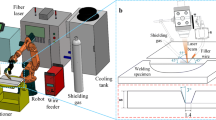Abstract
Laser welding of thick plates has been used in automobile and shipping industry owing to its focusing heat input, little welding deformation, and high productivity. Using narrow-gap technique can decrease the filling volumes of wire and increase the welding efficiency. However, its process is more complicated since it introduces filler wire to narrow-gap weld configurations. Usually the welding path, planning mainly depends on man’s experiences. Human factors have big influences on the quality of the joint. The aim of this paper is to study the interactions between welding parameters and the geometry of single bead using statistical methods. Then, the founded models were employed to plan the welding path, the number of filling passes, and layers in the multi-pass narrow nap joining. These results will provide supports for automatic multi-pass laser welding. The welding system includes a 10-kW Nd:YAG laser system, a KUKA robot, a Fronius wire feeder, and a 20-mm-thick high-strength ship steel with narrow gap. Laser power, welding speed, and wire feed rate are input variables. The responses include the transversal area of the added metals, bead width, bead height, and the ratio of bead width to height. Verification experiments indicate that all these models can forecast the responses within the factor domain. Transversal section micrographs of the joints show that this method can get welding joint with less defects.
Similar content being viewed by others
References
Sun Z, Salminen AS (1997) Current status of laser welding with wire feed. Mater Manuf Process 12(5):759–777. doi:10.1080/10426919708935183
Moskvitin GV, Polyakov AN, Birger EM (2013) Application of laser welding methods in industrial production. Weld Int 27(7):572–580. doi:10.1080/09507116.2012.715953
Tommi J, Veli K (2003) High power Nd:YAG laser welding in manufacturing of vacuum vessel of fusion reactor. Fusion Eng Des 69:349–353
Massey S (2012) State-of-the-art in narrow groove welding technology and techniques. In: Summary report SR. EWI, USA
Malin VY (1983) The state-of-the-art of narrow gap welding. Weld J 62(6):37–46
Milewski JO, Sklar E, Santa Fe (1998) Narrow gap laser welding: United States, NO. 5760365, Jun 2
Muruganetal S (1998) Temperature distribution during multi-pass welding of plates. Int J Press Vessel Pip 75(12):891–905. doi:10.1016/S0308-0161(98)00094-5
Lucas MJ (1975) Narrow-groove welding: United States, NO. 3924095, Dec. 2
Schiltz H (1993) Electron beam welding. Woodhead, England, pp 3–5
Shannon GJ, Davitt C, Steen WM (1997) Thick section laser butt welding of structural steel using a coaxial powder filler nozzle. ICALEO ’97: Laser Materials Processing
Yu YC, Yang SL, Yin Y, Wang CM, Hu XY, Meng XX, Yu SF (2013) Multi-pass laser welding of thick plate with filler wire by using a narrow gap joint configuration. J Mech Sci Technol 27(7):2125–2131. doi:10.1007/s12206-013-0525-9
Webster S, Kristensen JK, Petring D (2008) Joining of thick section steels using hybrid laser welding. Ironmak Steelmak 35(7):496–504. doi:10.1179/174328108X358505 (9)
Zhang XD, Ashida E, Tarasawa S, Anma Y, Okada M, Katayama S, Mizutani M (2011) Welding of thick stainless steel plates up to 50 mm with high brightness lasers. J Laser Appl 23(2):1–7. doi:10.2351/1.3567961
Benyounis KY, Olabi AG (2008) Optimization of different welding processes using statistical and numerical approaches—a reference guide. Adv Eng Softw 39(6):483–496. doi:10.1016/j.advengsoft.2007.03.012
Lee HK, Han HS, Son KJ, Hong SB (2006) Optimization of Nd-YAG laser welding parameters for sealing small titanium tube ends. Mater Sci Eng 415(1):149–155. doi:10.1016/j.msea.2005.09.059
Park YW, Rhee S (2008) Process modeling and parameter optimization using neural network and genetic algorithms for aluminum laser welding automation. Int J Adv Manuf Technol 37(9–10):1014–1021. doi:10.1007/s00170-007-1039-3
Elmesalamy AS, Li L, Francis JA, Sezer HK (2013) Understanding the process parameter interactions in multiple-pass ultra-narrow-gap laser welding of thick-section stainless steels. Int J Adv Manuf Technol 68(1–4):1–17. doi:10.1007/s00170-013-4739-x
Shahi AS, Pandey S, Gill JS (2007) Effect of auxiliary preheating of filler wire on dilution in gas metal arc stainless steel surfacing using RSM. Surf Eng 23(5):384–390. doi:10.2179/174329407X247127
Salminen AS (2003) The effects of filler wire feed on the efficiency of laser welding. In: First international symposium on high-power laser macroprocessing. Proceedings of SPIE 4831: 263–268
Kah P, Martikainen J (2013) Influence of shielding gases in the welding of metals. Int J Adv Manuf Technol 64(9–12):1411–1421. doi:10.1007/s00170-012-4111-6
Leigh S, Sezer K, Li L, Grafton-Reed C, Cuttell M (2009) Statistical analysis of recast formation in laser drilled acute blind holes in CMSX-4 nickel superalloy. Int J Adv Manuf Technol 43(11):1094–1105. doi:10.1007/s00170-008-1789-6
Reisgen U, Schleser M, Mokrov O, Ahmed E (2012) Statistical modeling of laser welding of DP/TRIP steel sheets. Opt Laser Technol 44(1):92–101. doi:10.1016/j.optlastec.2011.05.025
Khan MMA, Romoli L, Marco F, Dini G, Sarri F (2012) Multi-response optimization of laser welding of stainless steels in a constrained fillet joint configuration using RSM. Int J Adv Manuf Technol 62:587–603. doi:10.1007/s00170-011-3835-z
Arata Y, Maruo H, Miyamoto I, Nishio R (1986) High power CO2 laser welding of thick plate—multipass welding with filler wire. Trans JWRI 15(2):199–206
Salminen AS, Kujanpää VP (2003) Effect of wire feed position on laser welding with filler wire. J Laser Appl 15(2):1–10. doi:10.2351/1.1514220
Manonmani K, Murugan N, Buvanasekaran G (2007) Effects of process parameters on the bead geometry of laser beam butt welded stainless steel sheets. Int J Adv Manuf Technol 32:1125–1133. doi:10.1007/s00170-006-0432-7
Salminen A (2010) The filler wire—laser beam interaction during laser welding with low alloyed steel filler wire. Mechanika 4(84):67–74
Author information
Authors and Affiliations
Corresponding author
Rights and permissions
About this article
Cite this article
Shi, H., Zhang, K., Xu, Z. et al. Applying statistical models optimize the process of multi-pass narrow-gap laser welding with filler wire. Int J Adv Manuf Technol 75, 279–291 (2014). https://doi.org/10.1007/s00170-014-6159-y
Received:
Accepted:
Published:
Issue Date:
DOI: https://doi.org/10.1007/s00170-014-6159-y




